The Role of Mechanical Screening in the MRF of the Future
November 4, 2022
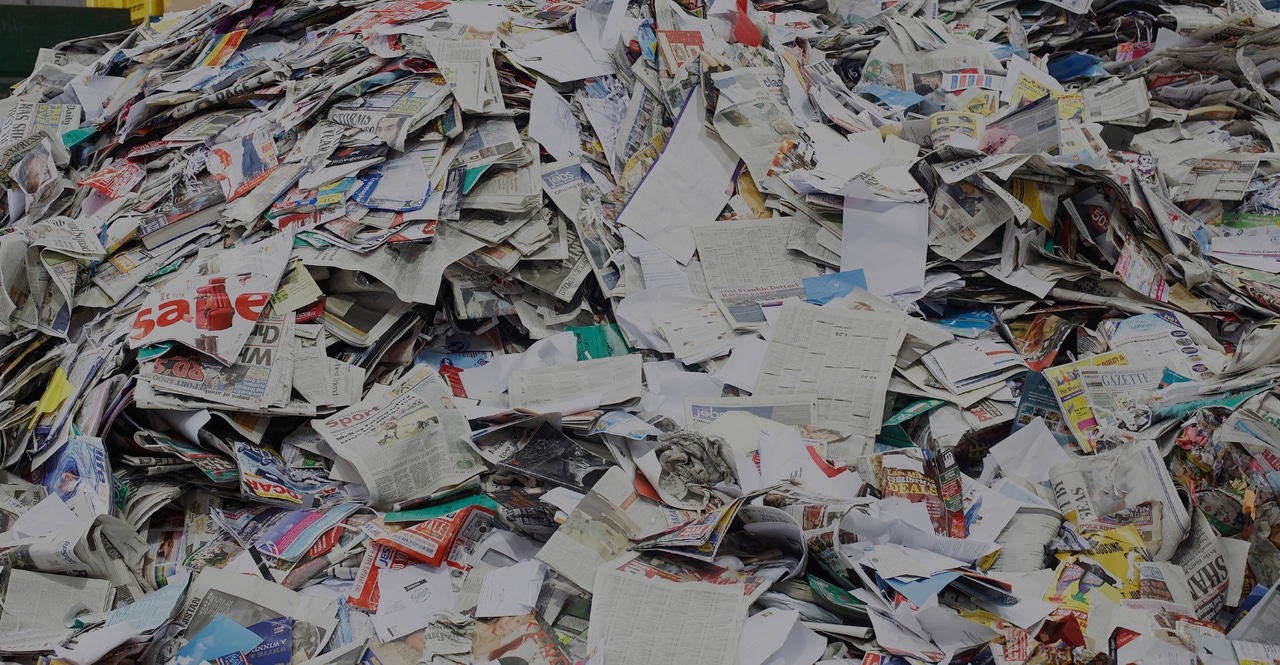
Sponsored by CP Group
Abstract
The recycling stream is changing and Material Recovery Facilities (MRFs) need to change along with it.
As packaging changes and diversifies, the ability of traditional mechanical screens to produce finished end-products in a MRF is diminished, resulting in more sorting downstream – either manual or automated – and increasing costs. To increase system efficiencies and support downstream sorting in a MRF, the old technologies of mechanical screening need to be re-examined and new solutions investigated.
Mechanical screens still provide several substantial benefits to automated sorting in a MRF. They increase material homogeneity going to downstream separation equipment, resulting in a higher yield and sorting efficiency. Due to the high throughput of mechanical screens, they are used at the front-end of the system to minimize the total number of optical or manual sorters required.
Traditional screens present drawbacks such as substantial cleaning requirements and the need to employ a manual pre-sort station upstream. Recent technology advancements eliminate these drawbacks enabling mechanical screens to retain their prominence in the MRF of the future.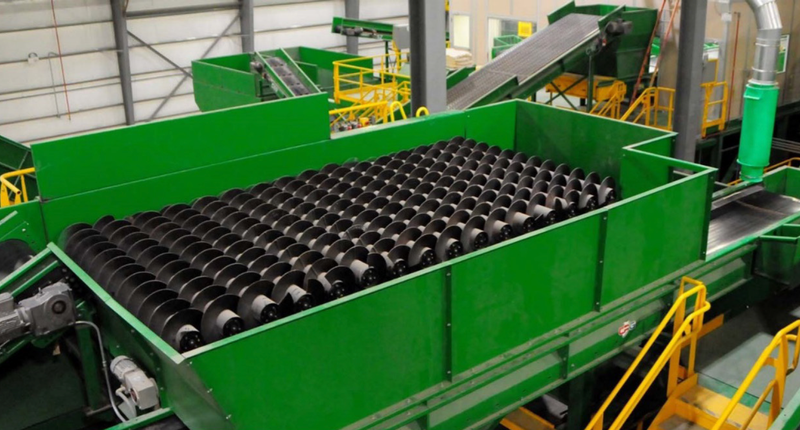
Background
Mechanical screens have a long history in solid waste processing and recycling. When curbside recycling programs started, screening technology in North America largely consisted of disc screens due to their low cost, relatively small size, and high throughput. Machines such as OCC screens, news screens as well as glass breaker screens are very familiar to those in the recycling industry.
In the early days of the MRF, these screens produced finished products in largely one step, with some manual quality control, by exploiting the mechanical properties of the material. Historically, OCC was large, ONP was fairly large, flexible and 2D, while containers were rigid and 3D.
However, changes to consumer product packaging and spending trends have changed the material stream over the last decade: less newspaper, more small cardboard, more residue. This means that additional downstream automated separation equipment is necessary on both the fiber and container lines which increases capital and operational cost – more people, more power, more air.
As noted by Dylan de Thomas, vice president of industry collaboration at The Recycling Partnership, “You’re seeing MRFs reinvest because they have to. Most of the MRFs in the United States were built for a totally different packaging stream than what we see today. And this has been coming down the pike for the last decade-plus. The Recycling Partnership’s recent “State of Curbside Recycling Report”, found that, while some MRFs have indeed invested in the future “many more need extensive modernization to be able to function efficiently.”
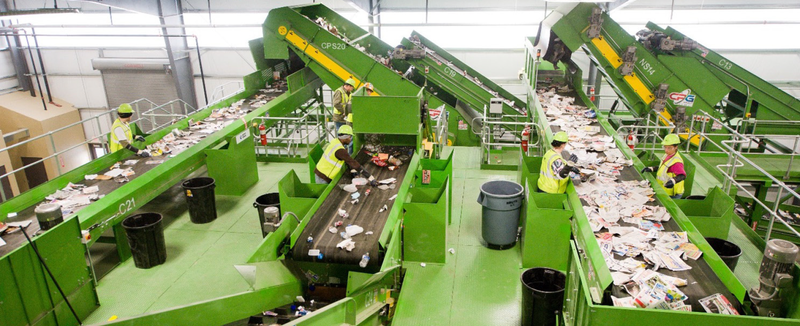
2012 MRF – a decade plus ago, finished products were largely produced directly from the fractions of disc screens, with some manual Q C. Modern MRFs require more separation automation due to the significant changes in the material stream.
The Challenge for Today’s MRF
The goal of a MRF is to have sorted materials at the end of the line. This is a steep challenge because the input stream is extremely heterogeneous. To sort this highly-variable input stream into sorted commodities, it must be fractionated, liberated and separated (sorted). Mechanical screens play an important role in that formula - fractionating and liberating.
Mechanical screens provide rough cuts based on mechanical properties that fractionate the stream into more similarly sized streams, liberate 2D from 3D, and remove grit, dirt and organics. They assist evening out material flows and burden depths on the downstream fiber and container sort lines. Although the industry has been enamored by automation the last several years, mechanical screens have clearly demonstrated their staying-power in a MRF. Simply put, no downstream automation can do its job without upstream mechanical screening.
Mechanical screens present potential unique operational hazards due to the nature of the material and process, mostly in cleaning and maintenance that adds to downtime. This is well understood and discussed on an on-going basis within the industry. Although recent advancements in disc screen technology have alleviated some of these operational costs (“non-wrap”, “anti-wrap”, etc.), there is one additional cost to screening that most do not consider - the operational cost of the pre-sort. It is traditional to manually sort non-program material after the infeed conveyor, such as bulky waste and wrapping hazards, prior to entering the mechanical screening and downstream sorting system.
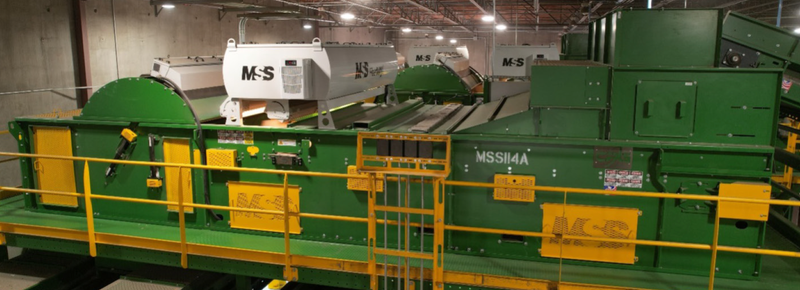
Optical sorters clearly benefit from the mechanical screens fractionating and liberating the material.
Pre-sort stations before mechanical screens result in bottlenecking or overloading, which either drastically decreases throughput or the sorting efficiency of the manual pre-sorters. With modern material streams becoming less dense, it is now more often the case that the pre-sort is both a bottleneck and overwhelmed by volume.
Consequently, many MRFs have to overstaff pre-sort stations in order to offset any potential reductions in sorting efficiency as pre-sorters often miss a significant portion of non-program materials because of high burden depths. In addition, the pre-sort is the most dangerous manual sort station in a MRF and is a source of downtime and/or lower throughput via use of pause pedals and e-stops.
Placing a manual sort station in front of mechanical screens and downstream automation doesn’t make sense. Machines are supposed to help people work, not the other way around. In the recycling industry, the people have always protected the machines. The way industrial automation should work is that the machines should protect the people. The manual sorters staffing the pre-sort have the hardest, dirtiest, and most dangerous job in a MRF because they receive no assistance from machines.
Nowadays, technology is available to fully automate the downstream fiber and container lines. In those cases, it is a matter of cost/ benefit analysis to determine how much automation to use.
However, the pre-sort is currently the only sort station in a MRF without an option for automation. It is difficult to automate a pre-sort in any type of MRF because the burden depth and material variety is, by definition, too large for automation to handle with any efficiency. Non-program material will always need to be removed from the finished product, one way or another. While optical sorters and robots can currently handle smaller and more narrowly defined items, their ability to handle either bulky or stringy hazard materials is either limited or non-existent.
In order to have the opportunity to fully automate a MRF, a new innovation was needed.
Typical MRF Pre-Sort

The old way of designing an MRF. Overburdened, high material depth, unsafe workspace, many sorters needed and a typical system bottleneck. No machines before the sorters.
OCC Auger Screen Post-Sort (QC)
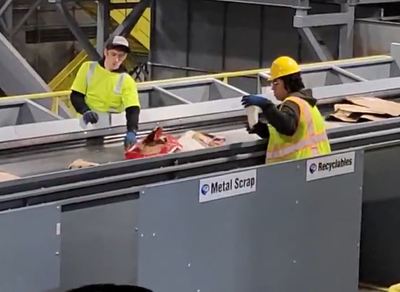
The new, innovative MRF design. Decreased material burden depth, less sorters needed, and improved worker safety. The machine is before any sorters.
There is an obvious and cost-effective solution to these problems: a mechanical sizing screen that doesn’t wrap, doesn’t jam, and maintains high throughput. Such machines have been claimed before, but whether disc screens, trommel screens or vibratory screens, all of them have fallen short.
Trommels and vibratory screens have limited throughput on MRF material in addition to being expensive in capital and operational costs on a per ton basis. Vibratory screens have low agitation and sort efficiency. And both still necessitate cleaning. Modern disc screens can strongly mitigate wrapping hazards, but still cannot not be run without a pre-sort.
A recent technological development presents an opportunity for a whole new type of mechanical sizing: the auger screen. An auger screen in many ways is similar to a disc screen as it consists of a series of parallel shafts, giving it many of the same advantages that allowed disc screens to dominate the domestic market. Unlike disc screens, auger screens are constructed of a series of continuous cantilevered screws, positioned adjacent to each other in such a way that any material that tries to wrap or jam on a shaft is transferred off the shaft by adjacent screws. In other words: the machine is continuously self-cleaning.

An auger screen goes directly after the infeed conveyor at a MRF and needs no presorting.
As of this publication there are dozens of sizing auger screens in commercial operation without a pre-sort, without a pre-shredder, and without daily, weekly or even monthly cleaning. The development and implementation of the auger screen removes all prior constraints regarding mechanical size screening in a MRF. It can be employed in a couple of key ways.
The first and most obvious is adding an auger screen in front of a manual pre-sort and OCC screen in a new or existing MRF. When running residential single stream or multi-family this solution can reduce pre-sort burden depth by up to 60%, therefore reducing both required labor and down time. When running commercial material the volume reduction is about 25% which, while less, still has the potential to relieve a critical bottleneck and increase overall system throughput. Additionally, manual labor is drastically reduced.
The most recent development is the new patented OCC Auger Screen which replaces the OCC disc screen commonly used throughout the industry. CP Group, San Diego, CA, an OEM specializing in MRF engineering and equipment, was recognized for this screen as the National Waste and Recycling Association’s 2022 Innovator of the Year Award winner. This prestigious award recognizes “recycling equipment designers and manufacturers that successfully challenge and advance recycling sector operations. It celebrates innovation in design and manufacturing that increases the effectiveness or efficiency of recycling equipment and operations.”
Specifically targeting mid to large sized cardboard, the OCC Auger Screen takes material straight off the tip floor and produces a screened OCC fraction with no pre-sort. Large hazard material is removed at the OCC quality control station out of a much-reduced burden of material, eliminating the pre-sort station entirely. In the future this sort station can be automated, a goal which is not possible with current pre-sort configurations.
Auger Screen “Overs”– Single Stream
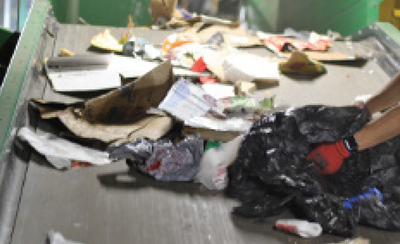
The fraction that goes over the Auger Screen. The manual post-sort station only sees large material with a significantly reduced burden depth.
Auger Screen “Unders”– Single Stream
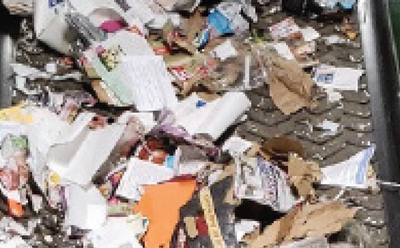
The fraction that falls through the Auger Screen – 60% of material, including sharps or other unsafe material, bypasses all manual sorters.
Modern MRF Insights
Dave Vaccarezza, owner of Cal-Waste, Galt, California, says CP Group’s Primary Auger Screen, “takes the burden depth down to a much more manageable level and does a great job of spreading everything out so there are no big lumps and clumps.” This machine also allowed Cal-Waste to reduce the number of sorters from eight on the pre-sort line to three or four on the OCC quality control station. By re-configuring the front-end of the MRF and adding more optical sorters on both the fiber and container lines, the MRF increased its capacity from 11 TPH to 30 TPH while reducing the manual sort workforce.
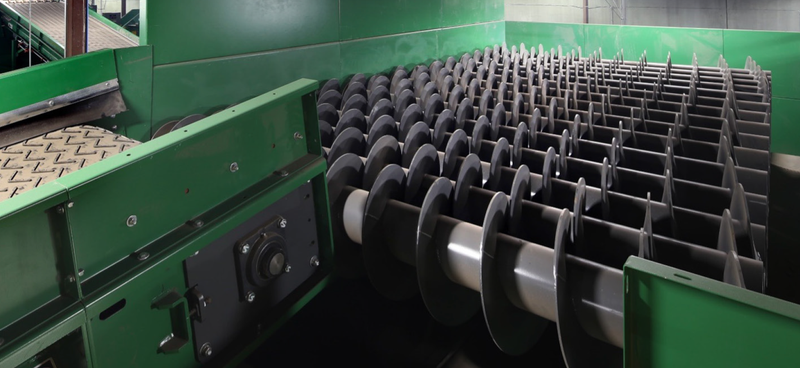
Primary Auger Screen (Cal-Waste Galt, CA). Three sorters on screen post-sort. No sorters prior to screen.
Elaine Morgan, Chief Executive Officer of Green Gorilla, New Zealand, has seen the benefits of having an Auger Screen from CP Group stating it has “distinct advantages over the inclined screen, as it has a higher rate of agitation which teases out the material making mechanical and manual recovery easier.” Further, “The auger has almost 100% uptime and no jamming, which has a big impact on throughput but also costs in idle labor.” Morgan notes that the biggest saving comes from “the reduced amount we send to landfill, saving on trucking and disposal costs.”
Michael McCoy, Metro Waste Authority Executive Director, Des Moines, IA, said, “MWA is the first single-stream processor in the world to adopt and implement the OCC Auger Screen. The screen, located at the front of the system, captures more material, decreases contamination, significantly reduces maintenance downtime, and eliminates the presort, making the process safer and much more effective.”
Brian White, District Manager of Waste Connections, Eugene, OR, said, “CP Group’s OCC Auger Screen has been a great addition to our operation. This machine does an exceptional job at producing a clean stream of OCC at an efficient pace with minimal downtime and cleaning necessary. The folks at CPG have been great to work with through this process and we will definitely work with them again for future projects.”
Auger Screens eliminates the operating cost concern of traditional screening technology. Used in series, they fractionate the material down to burden depths that automated sorting technologies can easily handle. By eliminating bottlenecks on the front-end in the MRF, the sort system can handle higher throughputs even with a decreasing density of material.
Whereas before it was not feasible, the elimination of the pre-sort opens up the potential to completely automate the front-end of a MRF system with automated sorting technologies.
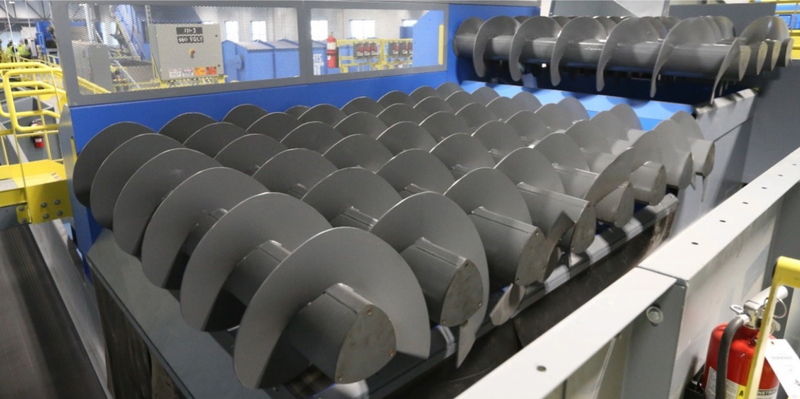
OCC Auger Screen (MWA, Des Moines, IA). Two to three OCC QC on screen post-sort. No manual sorters prior to screen.
Conclusion
Mechanical screens increase the throughput and efficiency of highly automated sort systems by fractionating and liberating the material. Prior generations of mechanical screens had several drawbacks which prevented a fully automated MRF from being developed. The development of robust anti-wrap auger screens allows the full benefit of mechanical screening to be utilized without any drawbacks.
The auger screen supports the MRF of the Future in terms of eliminating the pre-sort, decreasing system wide maintenance and downtime, as well as improving sorting efficiencies regardless of on-going changes in packaging and consumer behavior.
Eliminating the pre-sort is an important step towards a completely automated MRF. In order to achieve that, a durable, compact, high-capacity and low-maintenance machine was needed to take the entire brunt of the inbound material and fractionate it into more manageable streams. This is why the auger screen was developed and implemented, forever changing the landscape of MRF process flows. Auger screens are the first line of defense for human sorters as well as downstream equipment.
Auger screens have disrupted American MRF process flows. The disruption is welcomed and necessary. It is truly the first of its kind innovation and the catalyst that lends itself to the next phase in MRF process evolution and automation.
About CP Group
CP Group is a team of manufacturers and leaders of innovation in the waste and recycling industry. Our team is comprised of the most reliable brands in the industry including CP Manufacturing, Krause Manufacturing, MSS, and
Advanced MRF. We provide a variety of sort solutions worldwide, including MRF manufacturing, retrofits, audits, consulting, and engineering services. Custom turn-key systems are designed, in- stalled, and serviced by CP Group for residential recycling, commercial and industrial, municipal solid waste, engineered fuel, construction and demolition, and electronic waste processing.
We don’t just manufacture machines, we engineer solutions.
cpgrp.com
You May Also Like


